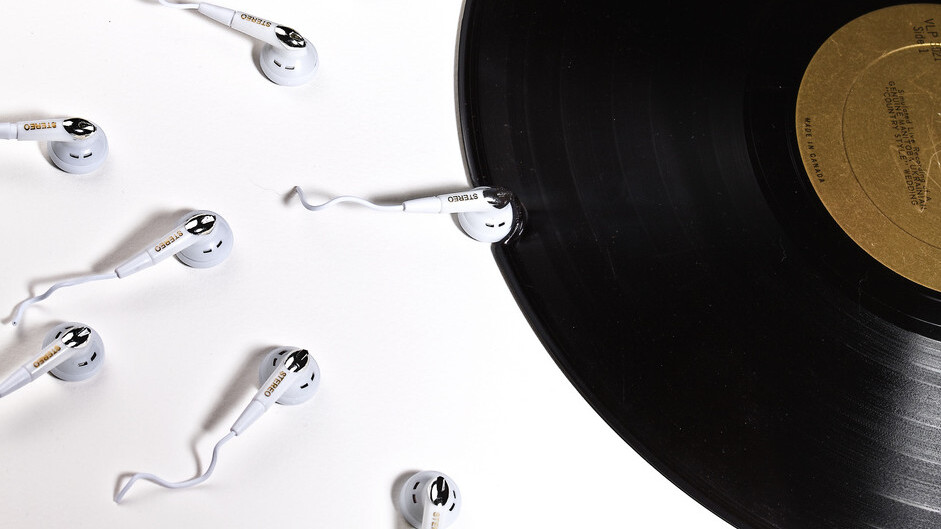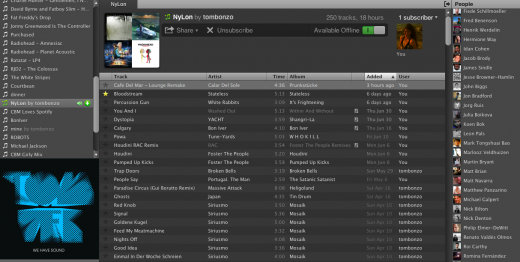
Music speaks what cannot be expressed, soothes the mind and gives it rest, heals the heart and makes it whole, flows from heaven to the soul.
-Angela Monet
Music, like travel and fine wine, is one of the greatest pleasures a human being can indulge in. In today’s rapidly changing digital landscape, we have a plethora of awesome options for discovering, sharing and enjoying music online, particularly in the U.S. Today the big news is that Spotify, the all-you-can-eat buffet of musical tunage, has officially launched in the U.S. But we’re also seeing badass services like Grooveshark slowly creeping through the digital rights forest, oldies like Internet radio’s Pandora hanging onto the baby boomers, and new cool kids on the scene like the 11-month old Rdio surfing the waters with more beauty than a Californian sunrise. So, which music service is right for you?
Spotify
 Why it’s awesome: As a very lucky tech journalist, I’ve been using Spotify for a few years now. With 13 million tracks at your finger tips, it’s my favorite music service overall. Since Spotify is available in the U.S. and most of Europe, it’s great if you’re a globetrotter or want to share playlists with your friends and lovers across the pond. The ability to create and maintain shared playlists is a favorite feature of mine. All your music is stored in the cloud and streamed over the Internet. Offline syncing is also available on both the mobile and desktop apps. At first glance, its UI and UX is similar to iTunes, albeit in grey and black.
Why it’s awesome: As a very lucky tech journalist, I’ve been using Spotify for a few years now. With 13 million tracks at your finger tips, it’s my favorite music service overall. Since Spotify is available in the U.S. and most of Europe, it’s great if you’re a globetrotter or want to share playlists with your friends and lovers across the pond. The ability to create and maintain shared playlists is a favorite feature of mine. All your music is stored in the cloud and streamed over the Internet. Offline syncing is also available on both the mobile and desktop apps. At first glance, its UI and UX is similar to iTunes, albeit in grey and black.
Pricing: Spotify offers a free plan, which allows you to stream millions of tracks locally from your computer, subsidized by advertising. For the first six months, a limit of 20 hours of listening will be in place for each month. After that, the limit will be 10 hours and you won’t be able to listen to a track more than 5 times. Spotify’s unlimited plan for $4.99 p/m gives you full, unrestricted access to your music from your computer whenever you want it. And there’s no advertising either. Lastly, the premium plan for $9.99 p/m provides access to Spotify on any device, to listen at any time. This gives you unlimited access to music, no advertising and you can listen on your computer and mobile devices such as smartphones and tablets. Crucially, this also provides offline access to your playlists and gives a higher quality stream, not to mention exclusive content such as early album launches.

Socially: Spotify users can share playlists and recommend songs. Individual tracks can also be shared by hitting the small arrow on the Now Playing track in the sidebar. You have the option to connect your Facebook, Twitter, Windows Live Messenger accounts to send out links to your tracks. This feature also provides a way to send a message to another Spotify user using their username, although it’s not exactly intuitive. Spotify is tied deeply to Facebook, connecting you to your friends to see what they are playing, sharing and adding to their playlists. This is pretty much its own social discovery option that’s really usable. To add your Facebook account, there is a little icon on the top right of the client which provides a small right sidebar to connect your social networking account.
Mobile: Spotify just released its iPhone app in the U.S. The app is crisp and offline syncing is awesome. You’ve just got to make some room on your phone by deleting those old iTunes tracks! Check out Spotify on Android here.
Why it’s lame: I’m quite the needy music fan, and sometimes Spotify doesn’t deliver the hot new tracks and remixes that I can find on The Hype Machine or Grooveshark. It isn’t mind-blowing on a social level and its exploration and discovery features need a lot of work. For example, why when I sign onto Spotify does it show me Britney Spears’ new C.D.? Surely, nothing in my Spotify library would prompt this suggestion.
*For those in the United States, invites are slowly rolling out, so if you don’t have one yet I suggest you head over to the Spotify website and apply. See our full story on Spotify so far here and read our beginner’s tips here. Once you’re all hooked up, rock out on Spotify TNW style:
Rdio
![]() Why it’s awesome: Rdio, pronounced “ar-dee-o,” only opened its doors on Aug 10, 2010, just 11 months ago, and the service already boasts a collection of 9 million songs. The service, which is currently available only in the U.S. and Canada, is best known for its rocking social features and gorgeous UX/UI. It’s a much more visually pleasing design than any of the services on this list. It’s also web based. Meanwhile, with Spotify you need to download its desktop client. Rdio has a desktop client if users prefer but it’s nice that you can access the service anywhere with a browser. As a result of being web based, its development cycles are much faster and there’s no need for software updates.
Why it’s awesome: Rdio, pronounced “ar-dee-o,” only opened its doors on Aug 10, 2010, just 11 months ago, and the service already boasts a collection of 9 million songs. The service, which is currently available only in the U.S. and Canada, is best known for its rocking social features and gorgeous UX/UI. It’s a much more visually pleasing design than any of the services on this list. It’s also web based. Meanwhile, with Spotify you need to download its desktop client. Rdio has a desktop client if users prefer but it’s nice that you can access the service anywhere with a browser. As a result of being web based, its development cycles are much faster and there’s no need for software updates.
This is an exciting time for the digital music industry and even more importantly, for people who love music. Consumers have many options, but we think they’ll ultimately gravitate to a service that fulfills the promise of what true social music discovery can be. Rdio has been built from the ground up to provide a simple, fun, and engaging way to discover new music through friends and family, as well as influencers like recording artists and music bloggers. Music is intrinsically social and the future of digital music will be driven by effective delivery of that social experience.
-Rdio CEO, Drew Larner
Pricing: Rdio Unlimited offers web, mobile and in-home music for $9.99 a month. Or for just $4.99/month, music fans can listen to Rdio on the web as much as they like, whenever they like. Bonus: Rdio provides seven full days of free and ad-free listening.

Socially: Rdio is radical. Where else can I see what music media rockstars Baratunde Thurston and Brian Lam are listening to in such a beautiful layout? Exploring music socially is far easier on Rdio than on Spotify, where exploring your friend’s music collections is much more manual, albeit still very fun. Lastly, Rdio is the only music service to have an embed player for Twitter – any links you tweet out from the service appear in your Twitter feed along with an embedded player.
On mobile, “Rdio’s iPhone app puts Spotify’s to shame,” says our Apple and West Coast Editor Matthew Panzarino. It’s true: Rdio’s app is awesome for sorting, discovery and browsing. Check out Rdio’s apps for iPhone, Android, Blackberry and Windows Mobile 7 here.
Lame: It’s only available in the U.S. and Canada, so you can’t share with your friends across the pond. You also have to dig into Rdio a bit more than the other apps. As a casual user I find the organization elements of Rdio a bit confusing. But maybe that’s just me being lame, unpatriotic and not digging in.
Pandora
![]() Why it’s awesome: Pandora is a lean back music service that’s only available in the United States. Pandora serves users musical selections similar to a song or band picked by the user. So if you like Fleet Foxes, you create a Fleet Foxes radio station and then Pandora serves up similar songs based on data from its Music Genome Project. The user then provides positive or negative feedback for songs chosen by the service, which are taken into account for future selections. Because Pandora is a streaming playlist of genetically connected tracks, it’s awesome for stumbling upon new music. It’s also the easiest music service to use, which is why it’s particularly popular with the Baby Boomer population.
Why it’s awesome: Pandora is a lean back music service that’s only available in the United States. Pandora serves users musical selections similar to a song or band picked by the user. So if you like Fleet Foxes, you create a Fleet Foxes radio station and then Pandora serves up similar songs based on data from its Music Genome Project. The user then provides positive or negative feedback for songs chosen by the service, which are taken into account for future selections. Because Pandora is a streaming playlist of genetically connected tracks, it’s awesome for stumbling upon new music. It’s also the easiest music service to use, which is why it’s particularly popular with the Baby Boomer population.
Pricing: Pandora comes in two versions: Free (ad supported) and Pandora One, which includes unlimited licensing, a desktop app, higher quality audio, the ability to skip tracks more frequently and no ads for $36.00 per year.
Socially: Pandora offers a Facebook connect to see what your friends are listening to on its service. Pretty amateur hour.
Mobile: Pandora is available for every mobile device here.

Lame: Pandora offers free, ad-supported music similar to Spotify but it’s ad-crazy to the point of being unlistenable. Pandora serves you an obnoxious ad every 3 songs. Its UI is awful and it hasn’t changed much since I started using it 11 years ago. And, it’s only available in the United States.
Grooveshark
 Why it’s awesome: Grooveshark streams 50 to 60 million songs per month to more than 5 million users worldwide, offering premium features to remove advertising and allow for streaming on Palm, BlackBerry and Nokia devices. The web interface is easy to use and its desktop app, built on Adobe Air, is almost exactly the same as the web. Grooveshark lets you search by artist, song, or album and you can pretty much find any song that you want. For example, I love the new song “Keep You” by Class Actress but it’s not on Spotify, it’s not on Rdio, but it is on Grooveshark, here. Grooveshark gets its content from letting users upload their own media so it usually has great remixes that can’t be found on Pandora, Spotify or Rdio.
Why it’s awesome: Grooveshark streams 50 to 60 million songs per month to more than 5 million users worldwide, offering premium features to remove advertising and allow for streaming on Palm, BlackBerry and Nokia devices. The web interface is easy to use and its desktop app, built on Adobe Air, is almost exactly the same as the web. Grooveshark lets you search by artist, song, or album and you can pretty much find any song that you want. For example, I love the new song “Keep You” by Class Actress but it’s not on Spotify, it’s not on Rdio, but it is on Grooveshark, here. Grooveshark gets its content from letting users upload their own media so it usually has great remixes that can’t be found on Pandora, Spotify or Rdio.
Grooveshark on the computer is always free. There are no monthly limitations and users can make an account, listen to their favorite songs endlessly, make playlists, upload their iTunes library to the cloud and have it available on Grooveshark, totally free. And because Grooveshark is a website, users can access the exact same playlists, cloud library, and Grooveshark catalog from any computer in the world with no hassle or installations.

Pricing: Access to Grooveshark Anywhere is $9/month, or $90 for a whole year. There’s also Grooveshark Plus account for $6/month, which is ad-free, includes customizable features, access to Grooveshark’s Desktop app, sneak peaks at new developments Last.fm scrobbling and unlimited library space.
Socially: On top of the ability to share songs and playlists to Twitter, Facebook, reddit, and other social networks, Grooveshark has recently added a new feature: Community. This shows a user all the activity of what their friends are listening to and discovering within the service. You can find out what your best friend just Favorited, or that your coworker just listened to 32 songs by Coldplay. And since Grooveshark lets people login using Facebook and Google accounts, it’s easy to find your friends on the site. They’ve also very recently added the ability for people to “comment” on a song–meaning you can leave a comment about a song on the site, and it will automatically post that comment out to your Facebook feed.
Mobile: Grooveshark has apps for jailbroken iPhone, Android, BlackBerry, and HP Palm WebOS that have the same features as the site.
Lame: The advertisements on the free version are pretty horrific. I really didn’t need to be served Fire & Ice branded Trojan condom ads. Most of the other downers on Grooveshark stem from the fact that it gets its content from letting users upload their own media. From this, problems like inconsistent naming, and unknown audio quality arise. In addition, music labels have issued copyright notices to the company, leading to the removal of both its iPhone and Android applications from Apple and Google’s marketplaces.
In conclusion….Pandora is for those who want an easy, lean back experience. Spotify and Rdio are for those who want to curate a collection of cloud-based music and want access to awesome mobile apps with mobile syncing. The only real difference at the moment comes down to four factors: UI, social, amount of tunage and regional differences. Rdio has an incredible UI and great social features. Spotify is available in both Europe and the U.S. and has 4 million more songs. No matter which service you choose to curate your main music collection, Grooveshark is awesome for on-demand music, available worldwide. We just hope it sticks around through these troubling legal times.
Other awesome music services to try: All the music you want for $10 a month with Rhapsody, The Hype Machine, “like the Techmeme of music”, Turntable.fm, everyone’s new favorite music app, which I stole the Awesome and Lame categories from, Extension.fm, a sweet Chrome extension for compiling music from around the Internets, the elegantly designed Internet radio 8Tracks, The Sixty One, which has a cool gaming element, Console.fm, a new chat room style electronica stream, which pulls from SoundCloud, another awesome service for uploading tracks and listening to sweet DJ mixes and of course the long-time father in the music scene, London-based Last.fm.
Get the TNW newsletter
Get the most important tech news in your inbox each week.





